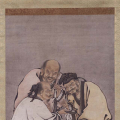Welcome home! Please contact lincoln@icrontic.com if you have any difficulty logging in or using the site. New registrations must be manually approved which may take several days. Can't log in? Try clearing your browser's cookies.
The Watcher
 Jeffrey
Veteran
Jeffrey
Veteran
7 years ago when I first came to my teacher. Lama Shenpen, I remember in my meditation I was this solid watcher and in my meditation it was like I was a statue. Though it was kind of peaceful now I feel more alive in my meditation.
The Internal Watcher
Lama Shenpen Hookham
Summary: A student comments on how she has used the technique of a 'watcher' to help her in overcoming certain habits; Lama Shenpen reminds us that both watcher and watched are thoughts.
A student writes:
"In Review of Section B (Coursebook 3, p. 70, ‘Discovering the Heart of Buddhism’): it says, “In particular we are warned of the mistake of setting up an internal ‘watcher’.’'
For many years now I have used this technique to great effect in relieving myself of less than useful habits. To me it is a powerful technique and, to be warned against it seems a little perplexing."
Lama Shenpen:
It is good to raise this issue because it is a subtle point that is being made here.
Obviously, it is important to be aware of what is going on and what we are doing. For that, a certain detachment is required, a kind of stepping back and watching what is going on.
However, if that becomes too strong a habit, it can lead to a kind of hardening of one's perception so that one identifies too much with the watcher as separate from the watched. This can lead to a certain insensitivity, a lack of spontaneity and relaxation.
The answer to this is to recognise that both watcher and watched are thoughts in the space of awareness. There is no hard and fast dichotomy. It is more a play in the space of awareness that can be very open and relaxed.
5






Comments
Woah...
It does lead to a certain insensitivity but in my view this is caused by objectivity. Instead of dwelling inside your head you are just listening to it. You have control by being able to decide what thoughts are valid and invalid. I tend to think of it as having 2 minds. I like to use my mind to read thoughts as the ear hears sounds. Sound arises as it is and then disappears.
Particularly helpful when dealing with depression. Did you know EVERY SINGLE PERSON with depression thinks he is worthless, no good and a pain in the ass to be around? If those thoughts were in any way accurate or based on truth we would have a lot of horrible people. I think, as those thoughts only keep you down, it is good to be able to switch "minds" and be the watcher.
Just my thoughts on the subject, peace.
A tibetan practioner once sent me a description of his meditation where included was...
"We shouldn't make a division in our meditation between perception and the field of perception. We shouldn't become like a cat watching a mouse. We should realize that the purpose of meditation is not to go deeply into ourselves or withdraw from the world.
Practice should be free and non-conceptual, unconstrained by introspection and concentration."
I don't know if this is something common within a Tibetan meditation practice but was struck by how similar it was to Zen's Shikantaza.
@Vajraheart once said to me that all turnings of the wheel of Dharma are as empty as everything else. I've read some Dogen and see no contradiction between what Dogen teaches and the Buddha teaches in the Pali canon.
I find the more that I read about Zen the more I understand about Theravada and vice-versa. AJahn Chah comes across as very Zen sometimes.
I have found many Tibetan and Zen teachings and practices are in essence one and the same, but that seems obvious to me as they have evolved from the same teacher but have over time been sieved through other minds.
As an aside - you talk of a 'field of perception'. When I meditate I tend to conceive of a 'field of awareness within which perceptions manifest'. What do you have to say to that, or do you suggest I just start a thread on the subject and see what others have to say on it?
In Zen meditation I try to allow all phenomena to arise, exist & depart, unmolested by my habituated impulses.
Your "Tending to conceive" is part of that molesting and would be a good example of an impulse best left unfed.
I think your question remains within the op's thread parameters.
Forgive my ignorance but what do you mean by the question remains within the 'op's thread parameters'
@ anataman
Sorry..Slow typing here.. I was saying that I thought your thread could stay here, instead of you starting another one, for it pertained so closely to Jeffreys.
The initial practice of concentration, for example in breath concentration or chanting, generates a sense of duality. 'I am counting my vipassana breaths', 'I am chanting', 'I am lifting my foot, my foot is lowering . . . gosh I am walking slowly', 'I am prostrating, add another notch on the mala'
. . . or perhaps in other systems, 'I am staring at a candle', 'I am telling you, Harry is Krishna' etc.
Then we integrate with the experience and experiences,
'Hari Rama',
'God is Greater',
'One . . . two . . . three',
'when is that &@cking gong being rung' . . .
This can lead to trance states and so the more gentle, 'being the experience', should be loose and free as well as not just 'mind meandering' . . .
Soon we may just sit by a river, entering the stream . . .
. . . where will it all end . . . or begin, come to that.
:orange:
We have a strong tendency to split up our world, especially between the perceived and the perceiver. Similarly, we often make a distinction between the doer and the action: I’m the doer and I am doing something, I am the speaker who is speaking. Most people consider the idea that there is a separate perceiver or a doer to be simple common sense. Buddhism challenges this assumption.
Part of what we learn to do in meditation practice is to steady our attention, to develop a simple, receptive awareness. Resting in receptive awareness is an antidote to our efforts of building and defending a self.
The assumption that there is “someone who is aware” falls away. Sometimes this is called an experience of non-dualistic awareness: the distinctions between perceiver and perceived disappear. There is no one who is aware; there is only awareness and experience happening within awareness.
There is an important difference between having something arise in meditation and feeding it. Here we are talking about just sitting. All the sense gates (eyes, ears, nose, tongue, body & mind ) are allowed to freely operate without hindrance or imbalance.
This simply means not identifying with, excluding or pushing one particular sense gate over any other.
Hey presto, instant anatta.
Cat and mouse juggling is not the issue. Skilful, which means appropriate, is the criterion [ceiling cat or @federica may be watching from above]
When I heard it my mouth dropped.
and Lobster's watching me
Woo-hoo !
To be clearer it should also be clarified that awareness is experience and experience is awareness, they are synonymous, there is no awareness besides experience nor an experience that is not aware. There is no larger awareness containing experience.
I don't think I'd kill the watcher but I'd shut it up for a while. Labelling experience while it's happening is like talking during a presentation.
Best
I think that is just delusion. Best